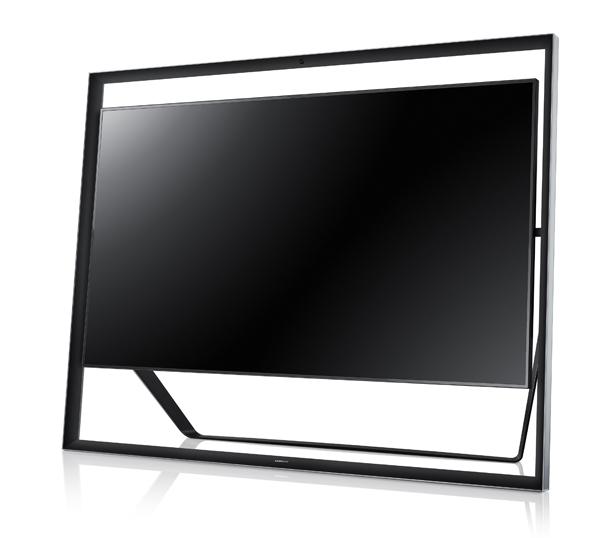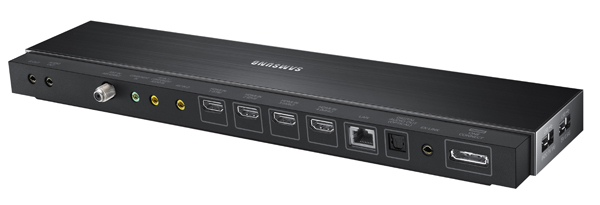The top part: Too much space between it and the TV's top.
Also, rounded edges would be more attractive.
Yep, I'm just not crazy about that stand's design; not complete to me.

AT A GLANCE
Plus
Accurate color
Superb resolution
Near state-of-the-art black level and shadow detail
Huge, bright picture
Minus
Price
THE VERDICT
The UN85S9AF is a hyper-expensive flagship for Samsung, and more of a technology demonstration than a product for the masses. But the money, as they say in Hollywood, is up there on the screen to see.
I once joked about the humongous 100-inch-plus HDTVs many manufacturers trot out at trade shows, suggesting that the best way to get them into your house was to place the TV where you thought it should go on the slab of your house under construction, then build the house around it. Samsung’s new 85-inch (diagonal) Ultra HD isn’t that big, but it’s close.
Sets this big present a problem for manufacturers and reviewers. They’re not easy to ship around for a review, not to mention the fact that they’re not produced in huge quantities from which a review sample can be easily drawn. We’ve reviewed the big Sony and LG 84-inch sets, but in each case under different circumstances. For the former, Sony invited us to their facility in San Diego and gave us a generous amount of uninterrupted time to work with the set—enough to cover all the bases sufficiently. They also provided us with some high-quality 4K source material. LG actually sent their 84-inch set to our studio and left it with us for weeks (our preferred mode of review), though the 4K source material they provided was limited and of mixed quality.
In this case, Samsung invited me to its West Coast PR offices in Los Angeles, where they had their 85-inch, UN85S9AF 4K Ultra HD set ready for inspection and testing. The difference from my Sony experience, however, was that I had only four hours to get the job done.
Nevertheless, that was sufficient for me to perform a full 2D calibration and spend enough quality time with the set to get a handle on its performance with upconverted standard HD source material from some of my own reference Blu-rays. Samsung provided their Photo Research PR-650 spectradiometer for the color calibration, and while they had other test tools available, for the rest of our needs, I used our own gear that I had brought along for the day, including an Oppo BDP-103 Blu-ray player. (Some of our video processing tests involve upconversion from a 480i source, and the Oppo is one of the few Blu-ray players today with a selectable 480i output.)

Time did not permit any 3D evaluations or calibrations. The set’s deep black level also worked against any meaningful contrast measurements. While Samsung apparently had some native 4K material on hand, they didn’t mention this until I was finished with the set. In any event, there wouldn’t have been more than few minutes left in my four-hour block to look at 4K programming. The evaluations reported in here were therefore limited to standard HD source material upconverted to the set’s native 3840 x 2160 resolution—the sort of material that would likely dominate your viewing for some time.
Also due to the time limitations, I made no attempt to dive into the set’s Smart TV capabilities. They appeared identical, or nearly so, to the features on Samsung’s other 2013 model year Ultra HD sets, including the UN65F9000AF Ultra HDTV and UN60F8000 LED HDTV we’ve also reported on.
Key Features
The S9 sample I tested still employed HDMI 1.4b. While this is sufficient for all current consumer source material, including 3840 x 2160 Ultra HD at up to 30 frames per second, it won’t allow for much more beyond that. Future enhancements that HDMI 1.4b can’t handle include 4K at 60fps, expanded color (such as Deep Color and/or x.v.Color) and more.
But a newer, more advanced version of HDMI which will add these capabilities is now on the way for the new 2014 models due later this year. Fortunately, this and all of Samsung’s 2013 Ultra HD models are upgradable because they employ an outboard connection box—the “One Connect” in Samsungese—for all of its inputs. A single proprietary cable connects the box to the set. By changing this One Connect (replacement cost TBD), a user can upgrade to newer version of HDMI without replacing the entire set. Most other 2013 UHD sets cannot accommodate the required change in hardware required for this update.
(Incidentally, you may have seen this new version of HDMI referred to as HDMI 2.0. But HDMI policy now frowns on attaching numbers to its various versions and requires that manufacturers no longer refer to the HDMI level of their sets by such numbers. Rather, they require that it be referred to as HDMI with 60fps, or HDMI with Deep Color, or whatever string of modifiers describe it correctly. Cue customer confusion.)
 The Samsung also comes with the company’s trackpad remote, which allows for voice or motion control. These features were not tested. To save my limited time, I asked for and received a more conventional Samsung remote.
The Samsung also comes with the company’s trackpad remote, which allows for voice or motion control. These features were not tested. To save my limited time, I asked for and received a more conventional Samsung remote.
Other features in the set include selectable Dynamic Contrast, a full color management system (the Custom setting of the Color Space control), both 2-point and 10-point White Balance adjustments, five gamma setting, and Smart LED. The latter is the local dimming feature, in this case, not edge-lit but multi-zone, backlitlocal dimming. Full array backlit local dimming has become increasingly rare of late, but if well designed, remains superior to any form of edge-lit local dimming.
Auto Motion Plus is Samsung’s “movie-to-soap-opera” control. Samsung’s version offers Custom settings that render the soap opera effect much less intrusive than normal if you choose to use it, though I did not. In addition, the Custom function allows for 24 frame per second content from Blu-ray, DVD, or set-top boxes to be viewed at multiples of 24 frames with no 3:2 pull-down. Turning Auto Motion Plus to Off position eliminates soap opera effect, but runs 24 frame sources at multiples of 60 Hz using a 3:2 frame pattern.
As noted earlier, the set’s 3D was not tested, but judging from the brightness I measured even with the backlight on 12 (maximum 20—see below), it should be more than adequately bright—though likely not as bright as the 4K sets we’ve tested that use passive glasses. The Samsung uses active glasses and comes with four pair.

The top part: Too much space between it and the TV's top.
Also, rounded edges would be more attractive.
Yep, I'm just not crazy about that stand's design; not complete to me.

Although the price of this TV is way out of my range it is encouraging to read about such an excellent product. At least we know Samsung understands how to make an excellent product and is willing to put it out there.
Eventually the tech in this TV will find it's way into reasonable priced products...
Thanks for checking it out for us.

I have been reading a lot about the new 4K "P' line from Vizio, and it includes a 70" model with full-array LED backlighting and 64 local dimming zones. Also Internet apps, AC wireless, 960 refresh rate, backlit remote, and a lot of other features. I heard the list price is going to be $2600. I am pretty sure Vizio isn't the only company that knows people aren't going to pay outrageous prices for TVs.Does Samsung honestly believe they can sell that TV for $40K? And I agree with David that the TV is ugly as hell. And how much use is a stand that only tilts up and down? Most people tilt their TVs left and right.
A little off-topic, but something that really steams me: I keep reading reviews of 4K TVs where the writers (from other magazines, of course. The esteemed authors at S&V would not be this dumb. LOL!)say that they cannot see how the TVs are of any use since you would need a huge screen to notice the difference in 4K upconversion, but these same writers rave about 10" tablet displays that have 2560 x 1440 resolution. What's up with that?